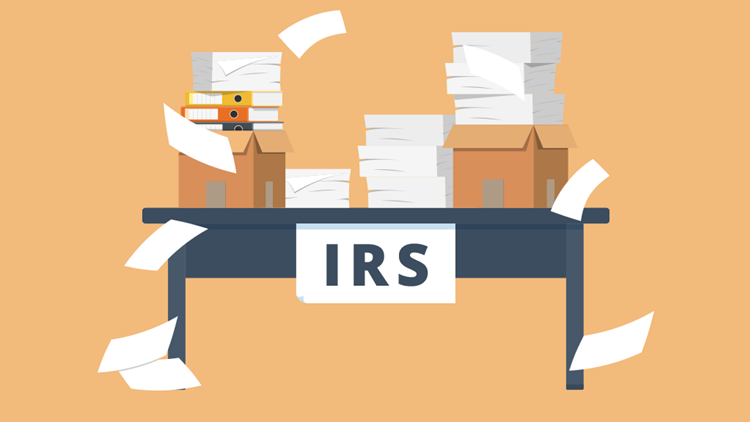by | Jan 12, 2022 | Tax Tips and News
“The most challenging year taxpayers and tax professionals have ever experienced.”
With that short sentence, National Taxpayer Advocate Erin Collins sums up her assessment of the calendar year 2021 and its effect on the Internal Revenue Service.
The assessment comes in the Taxpayers Advocate’s Annual Report to Congress, which details the struggles of last year – and a warning for this year’s tax season.
It was a tough job from the start
Collins says the IRS started 2021 behind the eight-ball, stuck between a lack of personnel due to the pandemic and new legislation meant to help counter the financial challenges brought on by the virus that relied on the IRS for implementation.
Collins’ report says the IRS performed well under these rough circumstances, issuing 478 million stimulus payments (also termed Economic Impact Payments or EIPs) totaling over $800 billion as they processed and sent out Advance Child Tax Credit (ACTC) payments to more than 36 million families that totaled over $90 billion.
The report says the IRS suffered the loss of 17% of its workforce in 2021, while its work load increased by nearly 20%.
Collins’ report says the message from the data is clear: 2021 had “no shortage of taxpayer problems.”
The IRS is still processing backlogs
“While my report focuses primarily on the problems of 2021, I am deeply concerned about the upcoming filing season,” Collins noted in the report. “Paper is the IRS’s Kryptonite, and the agency is still buried in it.”
As recently as December, the IRS still had backlogs of some 6 million unprocessed original individual Form 1040 returns, over 2 million unprocessed amended individual returns, and more than 2 million unprocessed Forms 941 and 941-X employer’s quarterly tax returns.
Add to all that another estimated 5 million pieces of taxpayer correspondence, some of which dates back to April and shows many taxpayers still waiting for refunds – nine months later.
Typically, e-filed returns are processed much quicker than paper ones, but the report found that millions of e-filed returns were suspended during processing because discrepancies were found between the amount claimed on the returns and amounts on IRS records.
Most of these revolved around the Recovery Rebate Credit (RRC) claims by taxpayers who didn’t get some or all of the economic impact payments the previous year. These returns had to be manually reviewed. As a result, more than 11 million math error notices were issued to taxpayers for such RRC discrepancies.
Delays in processing mean late refunds
When 2021’s tax deadline of May 17 dawned, the IRS still held more than 35 million tax returns so they could be reviewed by IRS staffers. About half were unprocessed paper returns; the other half were e-filed returns that were suspended during processing. Both instances created large delays for taxpayer refunds.
“Refund delays have a disproportionate impact on low-income taxpayers,” the report says. “Earned Income Tax Credit (EITC) benefits are worth up to $6,660, Child Tax Credit benefits [were] worth up to $2,000 per qualifying child under tax year 2020 rules, and RRCs are potentially worth several thousand dollars for families who did not receive some or all of their EIPs. Millions of taxpayers rely on the benefits from these programs to pay their basic living expenses, and when refunds are substantially delayed, the financial impact can range from mild inconvenience to severe financial hardship.”
Collins worries that the number of returns that are suspended or require manual processing could be high in 2022 as well. Recent legislation that authorized two advance credits could mean even more discrepancies between what is claimed on returns and what shows in the IRS records.
Increasing that risk, Congress also authorized a third round of economic impact payments that can be claimed as a credit by taxpayers who didn’t get the EIPs. Monthly payments of the Advance Child Tax Credit were also added to the mix in 2021.
All these payments have to be reconciled when the recipients file their 2021 returns this tax season. Despite IRS efforts to head off problems, the risk of discrepancies – and math error notices generated by them – remains high.
Customer Service Shortfalls Top the List
While a number of problems were noted by the report to Congress, Collins found some had widespread effects on IRS operations:
- The “Where’s My Refund?” tool wasn’t always the place for an answer. The online tool doesn’t give information on unprocessed returns and also won’t explain any status delays, reasons for delays or what actions taxpayers should take. For a lot of taxpayers, “Where’s My Refund?” just didn’t have a clue.
- Telephone service was the worst it’s ever been. The new credits like the Advance Child Tax Credit pushed call volumes to nearly triple from the year before; telephone support got a record 282 million telephone calls. Not that they were all answered. Customer service representatives only were able to actually answer about 11 percent of those. “Among the lucky one in nine callers who was able to reach a CSR, the IRS reported that hold times averaged 23 minutes,” the report says. “Practitioners and taxpayers have reported that hold times were often much longer, and frustration and dissatisfaction was high throughout the year with the low level of phone service.”
- It took months for the IRS to process taxpayer responses to its notices, delaying refunds. Tens of millions of taxpayers received one or more notices from the IRS during 2021. In many cases, a response was required by the receiving taxpayer and if the IRS automatic system didn’t process a response, the refund claimed on the return wasn’t released. Worse yet, the automated processes could actually take action against the taxpayer. The report found that while the IRS received over 6 million responses to notices from taxpayers, the agency took an average of nearly 200 days to process each of them.
The National Taxpayer Advocate also has some recommendations for Congress. On their tax to-do list:
- Provide the IRS with sufficient funding to improve taxpayer service and modernize its information technology systems.
- When the IRS postpones its tax-filing deadline, extend the period for receiving refunds.
- Authorize the IRS to establish minimum standards for paid tax return preparers.
- Expand the jurisdiction of the U.S. Tax Court to hear refund cases.
- Restructure the Earned Income Tax Credit (EITC); make it simpler for taxpayers and reduce the number of improper payments.
- Protect taxpayer rights by strengthening the Low Income Taxpayer Clinic (LITC) program.
For more information and the complete National Taxpayer Advocate report, visit 2021 National Taxpayer Advocate Annual Report to Congress.
Source: IR-2022-11
– Story provided by TaxingSubjects.com
by | Jan 11, 2022 | Tax Tips and News
The Internal Revenue Service is updating its Frequently Asked Questions to reflect changes on two fronts important to a lot of taxpayers.
The changes, in the form of revamped and increased guidance, are focused on the unemployment compensation exclusion for 2020, and the Recovery Rebate Credit for 2020.
Unemployment Compensation Exclusion
The American Rescue Plan made the unemployment compensation exclusion possible for 2020 filers. When a taxpayer’s account is corrected for the exclusion, the agency will mail a notice to the taxpayer, notifying them of the correction.
While the unemployment compensation exclusion, as explained in the IRS Fact Sheet 2022-01, is worth up to $10,200 for eligible taxpayers – or up to $10,200 for each spouse if married filing jointly – it doesn’t necessarily mean a taxpayer will receive that amount as a refund.
The exclusion allows qualified taxpayers to remove that amount from their taxable income, and so lower their tax liability for 2020. The exclusion could mean a refund to those taxpayers who have overpaid their unemployment compensation taxes, but it may not equal the maximum exclusion amount.
If the exclusion adjustment leads to a refund, the IRS says it will reach the taxpayer in one of two ways.
If the taxpayer’s bank account information is on file with the IRS, they’ll send the refund by direct deposit into the account. If the account isn’t on file, the taxpayer will instead receive a check by mail.
One important update to the FAQs lets taxpayers know that if they owe money to state or local governments, those debts could be repaid out of any refund they get in the unemployment compensation exclusion.
These debts can include past-due federal tax, state income tax, state unemployment compensation debts, child support, spousal support, or certain federal non-tax debts, such as student loans.
Taxpayers whose refunds go to pay such debts, called offsets, will get a notice from the IRS alerting them to the payments.
Recovery Rebate Credit
The second area to get the update treatment covers the payment of the Recovery Rebate Credit, and focuses on finding and using the first two Economic Impact Payment (EIP) amounts to calculate the credit for 2020.
Taxpayers who got the full amount of the Economic Impact Payments don’t need to claim the Recovery Rebate Credit on their 2020 tax return. A taxpayer got the full EIP if:
- The first Economic Impact Payment was $1,200 ($2,400 if married filing jointly) plus $500 for each qualifying child they had in 2020; and
- The second Economic Impact Payment was $600 ($1,200 if married filing jointly) plus $600 for each qualifying child they had in 2020.
A worksheet included in the 2020 Form 1040 and Form 1040-SR instructions can help taxpayers figure their eligibility.
The IRS says the first place to start to find if a taxpayer received both EIPs is to log into their online account with the IRS.
If a taxpayer qualified for an Economic Impact Payment and did not receive it, they can request a payment trace from the IRS. The agency stresses though, taxpayers should request a trace if their online account shows a first or second EIP was issued to them and they did not receive it.
Traces can’t be used to determine if a taxpayer was eligible for a payment, or to confirm the amount of payment the taxpayer should have gotten.
Taxpayers should call the IRS at 800.919.9835 to request a trace. They can also mail or fax a completed Form 3911, Taxpayer Statement Regarding Refund.
The IRS says generally taxpayers will hear back from them in about six weeks after they get the request for a trace. However, limited staffing may create delays. They also remind taxpayers NOT to file Form 3911 if they’ve already requested a trace by telephone.
For more on the updated FAQs on the Recovery Rebate Credit, check out IRS Fact Sheet 2022-02.
Sources: “2020 Unemployment Compensation Exclusion FAQs — Topic G: Receiving a Refund, Letter, or Notice“; “Recovery Rebate Credit — Topic F: Finding the First and Second Economic Impact Payment Amounts to Calculate the 2020 Recovery Rebate Credit“
– Story provided by TaxingSubjects.com
by | Jan 10, 2022 | Tax Tips and News
It’s official: The Internal Revenue Service says it will start accepting 2021 tax year returns on January 24, kicking off tax season.
The somewhat late start for individual tax filers allows the agency the extra time needed to get their computer systems programmed and tested. The IRS says extra programming is needed to cover those taxpayers who can claim the Child Tax Credit or the Recovery Rebate Credit after receiving advance portions of the credit earlier in the year.
“Planning for the nation’s filing season process is a massive undertaking, and IRS teams have been working non-stop these past several months to prepare,” said IRS Commissioner Chuck Rettig.
“The pandemic continues to create challenges, but the IRS reminds people there are important steps they can take to help ensure their tax return and refund don’t face processing delays. Filing electronically with direct deposit and avoiding a paper tax return is more important than ever this year. And we urge extra attention to those who received an Economic Impact Payment or an advance Child Tax Credit last year. People should make sure they report the correct amount on their tax return to avoid delays.”
In order to get their returns to the IRS by the April 18 tax deadline, Rettig and other federal tax officials are encouraging taxpayers to have their tax documents needed for filing in hand so they can file a complete and accurate return.
Just having an accurate return, the IRS stresses, can help avoid processing and refunding delays—as well as later IRS notices.
An accurate return is especially valuable to taxpayers who got advance payments of the Child Tax Credit or Economic Impact Payments from the American Rescue Plan in 2021. These recipients will need the amounts of their payments to include on their tax returns to verify their remaining credit amounts.
Some filers may not be required to file, yet need to file a return for 2021 in order to claim a Recovery Rebate Credit and get the tax credit from the 2021 stimulus payments or reconcile advance payments of the Child Tax Credit. They could also be eligible for other credits.
The filing deadline is April 18
This year’s deadline for filing and paying any tax due is Monday, April 18. Traditionally the deadline is April 14, but this year the Washington, D.C. holiday for Emancipation Day has bumped the IRS deadline day to the 18th.
Taxpayers in Maine and Massachusetts, however, have April 19 as their deadline, since their Patriots’ Day holiday interfered.
No matter where they live, though, taxpayers who request an extension this tax season have a final filing deadline of Monday, Oct. 17, 2022.
IRS is still processing returns from 2021
Commissioner Rettig says his agency is still fighting the battles of the pandemic, with short staff affecting processing of last year’s tax returns and fielding a record number of phone calls.
“In many areas, we are unable to deliver the amount of service and enforcement that our taxpayers and tax system deserves and needs. This is frustrating for taxpayers, for IRS employees and for me,” Rettig said.
“IRS employees want to do more, and we will continue in 2022 to do everything possible with the resources available to us. And we will continue to look for ways to improve. We want to deliver as much as possible while also protecting the health and safety of our employees and taxpayers. Additional resources are essential to helping our employees do more in 2022 – and beyond.”
The IRS says it’s hard at work to reduce the backlog of prior-year individual that haven’t been completely processed. It does say that all paper and electronic individual 2020 returns without issues have been processed if the return was submitted before the April deadline. There is some good news, in that taxpayers generally won’t need their 2020 return to be processed before they send in their 2021 returns. They can file when ready.
The men and women of the IRS won’t have much time to catch their breath, however. This tax season, some 160 million individual tax returns are expected for the 2021 tax year, and most of those are expected before the traditional April deadline.
Even with an increase in volume, the IRS expects most taxpayers will receive their refund within 21 days of when they file, provided they file electronically, choose direct deposit and there are no issues with their tax return.
Here are some dates to remember
Here are several important dates taxpayers need to heed during this year’s tax season:
- January 14: IRS Free File opens. Taxpayers can begin filing returns through IRS Free File partners; tax returns will be transmitted to the IRS starting January 24. Tax software companies also are accepting tax filings in advance.
- January 18: Due date for tax year 2021 fourth quarter estimated tax payment.
- January 24: IRS begins 2022 tax season. Individual 2021 tax returns begin being accepted and processing begins
- January 28: Earned Income Tax Credit Awareness Day to raise awareness of valuable tax credits available to many people – including the option to use prior-year income to qualify.
- April 18: Due date to file 2021 tax return or request extension and pay tax owed due to Emancipation Day holiday in Washington, D.C., even for those who live outside the area.
- April 19: Due date to file 2021 tax return or request extension and pay tax owed for those who live in MA or ME due to Patriots’ Day holiday
- October 17: Due date to file for those requesting an extension on their 2021 tax returns
Finally, here are some easy steps that can really ease stress levels this tax season:
Organize and gather up 2021 tax records, including Social Security numbers, Individual Taxpayer Identification Numbers (ITINs), Adoption Taxpayer Identification Numbers, and this year’s Identity Protection Personal Identification Numbers, valid for 2022.
Check IRS.gov for the latest tax information – including the latest on reconciling advance payments of the Child Tax Credit or claiming a Recovery Rebate Credit for missing stimulus payments. Remember: There’s no need to call the IRS.
Set up or log in at IRS.gov/account and access personal tax account information, including the balance, payments, tax records and adjusted gross income.
Make final estimated tax payments for the 2021 tax year by Tuesday, January 18, in order to avoid a tax bill and possible penalties.
Set up a bank account, prepaid debit card or mobile app to use direct deposit. Use their routing and account numbers on the tax return to set up the transfer.
File a complete and accurate return electronically once filing begins and choose direct deposit for the fastest refund.
Source: IR-2022-08
– Story provided by TaxingSubjects.com
by | Jan 7, 2022 | Tax Tips and News
Their lifeline comes in the form of a quarterly estimated tax payment, as long as it’s made for the fourth quarter of 2021 and gets to the IRS by Tuesday, January 18.
The IRS sees income taxes as a pay-as-you-go proposition, meaning Americans need to pay most of their tax as their income comes in.
Most taxpayers pay their tax in the form of withholding from their paychecks, pension payments and other government payments—including Social Security benefits, or unemployment compensation.
Investors and self-employed taxpayers, however, make quarterly estimated tax payments to the IRS over the course of the year. Other taxpayers also find this method works for them.
Some taxpayers actually use a combination of the two methods to help avoid a big unexpected tax bill when they file, avoiding a penalty at the same time.
Don’t wait to pay
What’s important isn’t just how much is paid to the IRS, but when. If a taxpayer failed to make estimated tax payments earlier in the year, they stand to decrease—and maybe even eliminate—a possible penalty by making a payment early in the year. That’s because the penalty calculation considers the date the payment was made.
Making a payment now, rather than waiting until the April filing deadline, often helps avoid those penalties.
When should taxpayers make estimated payments?
If a taxpayer owed tax when they filed their 2020 return and didn’t increase withholding for 2021, they could find themselves in the same mess come April.
Those who may fall into this trap include taxpayers who used to itemize but now take the standard deduction, those in two-wage-earner households, employees with non-wage income, and taxpayers with complex tax situations.
What’s more, taxpayers who got advance payments of the Child Tax Credit but don’t actually qualify for it could also have a tax-time surprise waiting for them. Making a quarterly estimated tax payment for the fourth quarter of 2021 could be a way out.
What else should taxpayers consider?
The IRS says there are some important points to consider when it comes to income and paying enough in taxes:
- Most income is taxable. Besides wages, interest and other investment income, which also includes income related to virtual currencies, refund interest and income from the gig economy are taxable.
- Unemployment compensation is fully taxable in 2021. The American Rescue Plan Act of 2021 allowed an exclusion of unemployment compensation of up to $10,200 for 2020 only. Often, this means that an estimated tax payment should be made, especially if no federal income tax was withheld from these payments.
- Various financial transactions, especially late in the year, can often have an unexpected tax impact. Examples include year-end and holiday bonuses, stock dividends, capital gain distributions from mutual funds, and stocks, bonds, virtual currency, real estate or other property sold at a profit.
Still unsure whether estimated tax payments are needed? The IRS website has a Tax Withholding Estimator that can help taxpayers decide if they need to make an estimated tax payment.
Another resource can be the estimated tax Form 1040-ES, which has a worksheet packaged with the form.
Taxpayers with a more complex income picture, such as dividend or capital gain income, or who owe alternative minimum tax or self-employment tax should consult Publication 505, Tax Withholding and Estimated Tax, for its worksheets, examples and other details.
How do taxpayers make a payment?
The IRS says its Direct Pay tool is the fastest and easiest method to make an electronic estimated tax payment. Taxpayers can use the tool to schedule a payment in advance of the January deadline.
Taxpayers can also use their IRS Online Account to make an estimated tax payment. Once logged in, users can also see their payment history as well as any pending or recent payments.
These methods are free to use—the IRS doesn’t charge a fee for the service. One other benefit for paying electronically: the payments are credited promptly once they’re made.
For more information on all the payment options available, visit IRS.gov/payments on the IRS website.
Source: IR-2022-03
– Story provided by TaxingSubjects.com
by | Jan 5, 2022 | Tax Tips and News
No doubt about it: The future for the IRS is electronic.
The agency is putting more and more formerly paper-only functions on its electronic platform, speeding up transmission and improving service as a result.
Form 1024, Application for Recognition of Exemption under Section 501(a) or Section 521 of the Internal Revenue Code, is the latest function to transition into the electronic world.

Previously, the only way non-profit organizations could use Form 1024 to apply for tax-exempt status was by submitting the paper form.
That is now changing.
As of January 3, submissions of Form 1024 must now be done online at PAY.gov.
However, the IRS is also offering a 90-day grace period that also allows paper submissions of Form 1024 (Rev. 01-2018) and letter applications. But once that passes, filing will be electronic-only.
“Electronic filing makes it easier to complete an application for tax-exempt status while reducing errors,” said Sunita Lough, Commissioner of the IRS Tax Exempt and Government Entities division. “Electronic filing also shortens IRS processing time so applicants won’t wait as long for a response.”
The electronic revised Form 1024 can also be used by organizations to request a determination under Section 521 instead of using Form 1028, Application for Recognition of Exemption Under Section 521 of the Internal Revenue Code.
The IRS says there are other changes, depending on which sections of code are used to claim exemption.
Electronic transmission of Form 1024, however, doesn’t mean that submitting the form is any cheaper. The required user fee is still $600 for 2022, payable through PAY.gov when the form is submitted.
The site accepts payments directly from a bank account as well as debit and credit cards.
For more information on how to apply for tax-exempt status, check out Revenue Procedure 2022-8 and Applying for Tax-Exempt Status on IRS.gov.
Source: IR-2022-2
– Story provided by TaxingSubjects.com
by | Jan 4, 2022 | Tax Tips and News
Victims of the New Year wildfires in Colorado now have one less thing to worry about. The Internal Revenue Service has given individual and business taxpayers affected by the disaster until May 16 to file and pay an array of federal taxes.
The fires started December 30, wiping out hundreds of homes in Boulder County. At present, the Federal Emergency Management Agency (FEMA) has declared all of Boulder County a federal disaster area, allowing any residents and businesses within the county to qualify for the IRS relief measures.

If FEMA expands the disaster declaration to cover more counties or locations, those new areas would automatically be included in the IRS relief provisions. A current list of eligible locations can be found on the disaster relief page of the IRS website.
More time to file and pay
The IRS relief delays various tax deadlines for filing and payment that would otherwise have occurred between December 30 and May 16. Individual taxpayers and businesses within the disaster area now have until May 16 to file their returns and pay any taxes that would have been due during the postponement period.
The new May 16 deadline applies to:
- 2021 individual income tax returns that would have been due otherwise on April 18;
- 2021 business returns that would have been due in March and April;
- Quarterly estimated income tax payments otherwise due on January 31 and May 2 (taxpayers can skip the fourth-quarter estimated tax payment normally due on January 18, and simply include it with the 2021 return when they file—or send it in to the IRS before May 16).
For a complete list of the tax returns, payments and other tax-related items that qualify for the IRS relief, see the Disaster Assistance and Emergency Relief for Individuals and Businesses page on IRS.gov.
Relief measures are automatic
The extended deadlines and other relief measures are applied automatically to those taxpayers inside the federally declared disaster area. Taxpayers do not need to contact the IRS to qualify for the relief.
That said, if a taxpayer within the disaster area gets a notice of late filing or late payment from the IRS with a due date within the December 30-May 16 time frame, the taxpayer should call the number printed on the notice to have the penalty abated.
Taxpayers with uninsured or unreimbursed losses due to the fires can choose to make the claim either on the return for the year the loss occurred, or on the return for the previous year. The IRS reminds filers to write the FEMA declaration number 4634DR on returns that claim such a loss.
Publication 547 has details on claiming disaster-related losses.
Source: IR-2022-01
– Story provided by TaxingSubjects.com








